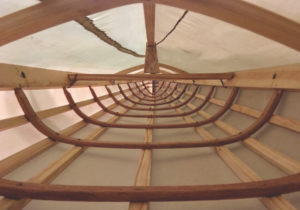EASTHAM — From the seat of my kayak I have come to see Nauset Marsh, part of the Cape Cod National Seashore in Eastham, as the Everglades of New England: more wilderness than civilization, a place for endless exploration.
My family started kayaking when the kids were small, and we had a typical pair of heavy plastic open-cockpit tandems that could take coolers, dogs, and everything for a day at the beach. Age has seen me through a progression of lighter, more high-tech kayaks made of fiberglass or carbon fiber.

The only way to get lighter would be to reach back in time to a skin-on-frame kayak like the ones made by the indigenous people of the Aleutian Islands in Alaska for thousands of years. Or the one found in Greenland over 100 years ago by Provincetown native and Arctic explorer Donald MacMillan (the guy the wharf is named for), which can be seen at the Provincetown Museum on High Pole Hill.
A couple of weeks ago I drove to Delaware to join seven others at the week-long Delmarva Paddlers Retreat. The goal was to build our kayaks in six days, then have three more to play with them in the shallow tidal waters of the western shore of Rehoboth Bay.
Our teachers had done a lot of prep work before we students arrived. Anders Thygesen, a Dane who lives in Norway, came to the U.S. with his partner and assistant, Jannie Heegaard, just to teach this workshop. Thygesen has paddled the entire coast of Norway, from the Russian border to the southern tip.
We did not build from kits, but we did not exactly start from scratch either. White pine boards had been selected for straight grain with no knots, then paired and cut to length for the gunwales, each marked at the midpoint and labeled with our names.
“In Western boatbuilding, you start from the keel and build up,” Thygesen said. “In Inuit boatbuilding, you start from the deck and work down.”
Kayaks of one form or another are known all around the Arctic by various names. By the mid-20th century interest in them was no more than a sputtering flicker before being revived by a small group of people, both indigenous and outsider.
Six of the workshop participants made Greenland-style kayaks, while one other person and I made boats based on a design from the Aleutian Islands of Alaska that are known by the Russian name baidarka (“little boat”) or the Unangan name iqyax. Originally used for seal hunting, they are long and sleek. The European explorers who first observed them a few hundred years ago were impressed with their seaworthiness in rough, open waters.
“This will be a fast boat,” said Heegaard as I got started. “I love mine.”
We began by taking measurements to tailor the boats to our own dimensions. The kayaks could be wider or narrower, as we wished. Instead of adjustable foot pedals, they would have a footboard integrated in the deck at just the right length.
On the first day we carved mortises that would accept the ribs, attached the gunwales to each other at bow and stern using wooden plates secured with pegs, and used temporary spreaders to shape the deck. For six days we worked from 8 a.m. to 8 p.m. with only a few breaks.
We spent four days making the frames and then one day covering them with “skin” (we used a synthetic fabric rather than the traditional walrus or sealskin) and one day finishing the stitching, fitting the coaming, and painting. Some people were able to apply at least one coat of varnish on day six, but most of us went into overtime.
The most impressive part of the operation was Thygesen steam-bending the ribs for each kayak and carefully shaping the hull as he went with a truly practiced eye. All the joinery was done with pegs that we made ourselves from dowels and a few lashings. No glue, no nails, no screws. The skin holds it all together and gets stitched taut.

And when the building was done, on the eighth day, we were able to take our new boats out on the bay. Paddling a handmade skin-on-frame kayak feels nothing like paddling a manufactured boat made from plastic or fiberglass. Wood is stiff but flexible, and the joints are, too. The kayak feels less like an object and more like a living thing.
And mine was fast, as Heegaard had said it would be. Once I was back on shore, Thygesen took a turn, racing it against one of the other builders for about 100 yards and winning.
None of us had ever built a kayak before. Plenty of mistakes were made and corrected, but there were no injuries worse than scratches or bruised thumbs. Accepting that perfection is not possible, the question became what mistakes can be tolerated and what mistakes must be corrected. Lessons learned in youth came to mind: A gentle hand guides the saw. Let the tool do the work. Plane with the grain.
In the end, it seemed to me the event really was a workshop in a much older sense of the word, with one master craftsman, Thygesen, who did the truly skilled tasks like bending the ribs, and eight less experienced apprentices doing the more menial tasks.
Before I went, friends asked me, “Are you really going to be able to build a boat in six days?” And I responded, “That’s the plan.”
Now I realize what Thygesen did during the workshop would have taken us years to learn. We were not each building a kayak in six days. We were helping him build eight kayaks in six days.
The Delmarva Paddlers Retreat has been held for 31 years by Qajaq USA, an organization that promotes kayaking in the Arctic tradition.



